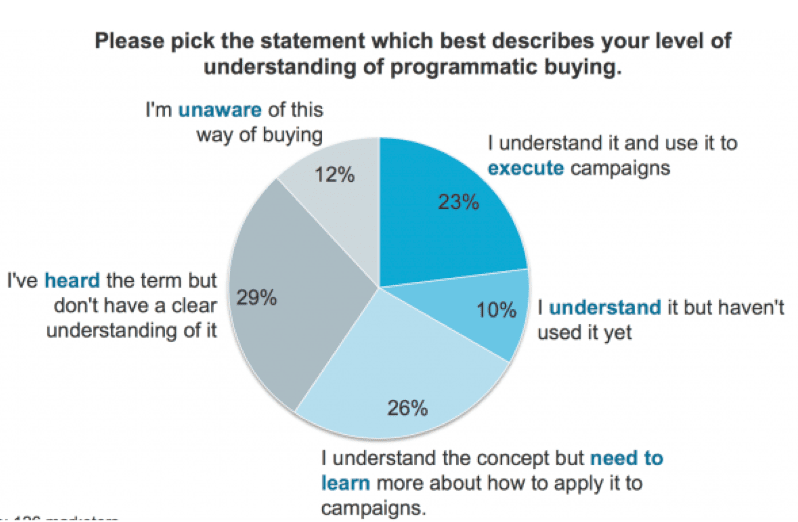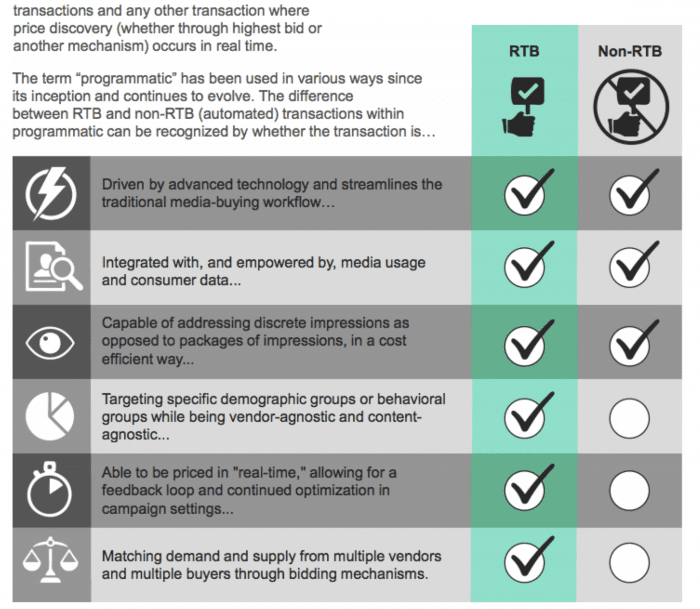A quick-fire guide and glossary to the essentials of Programmatic Marketing
Programmatic is a very hot topic in the world of marketing right now. As Ad Age points out, the advertising industry is on a journey toward widespread automation, and programmatic marketing which gives marketers the opportunity to purchase advertising more efficiently and - given the right data - more effectively, too.
As a relative newcomer to the world of Programmatic Marketing, I was overwhelmed by the amount of definitions and TLAs (Three-letter acronyms) involved with programmatic. Trying to get to grips with programmatic can really make your head spin! I therefore thought I might be an ideal person to provide a hopefully simple introduction to programmatic for anyone looking to understand this marketing technique for the first time.
Download free resource – Programmatic Marketing Brief
Learn the key questions to ask when managing Programmatic.
Access the
As a follow-up to Rob’s definition of Programmatic Marketing, rather than producing a lengthy guide (Smart Insights’ excellent revamped guide explains all in detail), I thought it might be useful instead to provide a quick overview of the key principles of Programmatic Marketing and a glossary of some of the main terms (jargon?!)
Introduction to programmatic
So, what exactly is programmatic marketing? Smart Insights defines Programmatic marketing as:
Bidding on an advertising inventory source in real time, for the opportunity to show one specific ad, to one consumer, in one specific context
Programmatic Marketing is essentially about using real-time technology (the majority of the time) to deliver the most relevant messages to targeted consumers in order to maximise response. Through audience insights, messages are tailored to the right person, at the right moment, in the right context, usually via display ads, although increasingly through other formats such as video, too.
Data is key
Data is becoming increasingly important to marketers and programmatic marketing thrives on quality data.
Effective programmatic marketing combines data from the audience (including demographics, location, interests and behaviour) and the environment to provide a more engaging, relevant experience. This data can be first, second or third-party, with first-party data (gathered from owned channels) providing the greatest insight into customers.
The opportunity: personalisation
Programmatic marketing gives marketers the opportunity to personalise at scale and to reach different customers with different creative messaging across media channels and partners.
Because advertisers buy impressions individually (not grouped by thousands or millions), each ad marketplace allows an advertiser to serve one specific ad to one single consumer in one single context.
Programmatic technology therefore offers the promise of ‘life-pattern marketing’, enabling marketers to reach consumers at key moments in their days with powerful messaging. Along with a response signal, this technology can identify what resonates with individuals at the moment-to-moment level to optimise the timing, relevance and effectiveness of the ads they see.
The business case
Programmatic marketing is growing at an incredible rate, with eMarketer estimating that it’s on track to make up 59% of total US digital display advertising spending in 2016 - $15.43 billion (over $5 billion from 2015), prompting many to suggest that programmatic is the future of online advertising.
The chart below from BI Intelligence summarise some future projections:

Whilst there are a number of potential downsides to programmatic that marketers must consider (including inventory quality, cost implications, and fraud), it nevertheless offers some major benefits for marketers, including:
- Pay only for the consumers you want, in contexts that generate impact
- Enrich the consumer experience with more first-party data
- Increase reach across many more properties than just a handful of sites
- Scale campaigns up to very large volume
- Show maximum campaign effect, with the best return
A glossary of top programmatic terms
A Forrester study from 2014 that found that only 23% of marketers understood programmatic buying, a clear indication that this is an area many still find confusing:

Part of the confusion is no doubt due to the terminology involved and I’ve therefore picked out some key terms and phrases. This is by no means an exhaustive list (others are much more comprehensive) but will hopefully give you a primer before delving into more detail:
Programmatic buying
Programmatic ad buying refers to the use of automation software to purchase digital advertising on a web page. Ad space can be bought in two ways: directly or through real-time bidding.
Programmatic direct
Programmatic direct (aka programmatic guaranteed, programmatic premium, programmatic reserved) is where automated software is used to buy guaranteed ad space (impressions) in advance from specific publishers. This approach does not involve an auction and the benefits relate to a more efficient ad buying process (the automated process is quicker, offers more pricing control, faster access to ad inventory and provides analytics).
Real-time bidding (RTB)
The process of buying digital inventory from multiple publishers on an impression-by-impression basis, typically involving an auction pricing mechanism and bidding strategies determined by pre-defined rules or algorithms.
'Programmatic Marketing' or advertising is a general term, so it's best to divide it based on whether it involves Real-time Bidding (RTB) or not. Often Programmatic is only considered to be real-time transactions to bid This summary explaining the difference between RTB and non RTB Programmatic from the Magna Global report is useful to show the differences.

Ad exchange/ marketplace
An ad exchange or marketplace is an auction-based platform that enables multiple parties, including advertisers, publishers and ad networks, to buy and sell advertising inventory to the highest bidder. Prominent ad exchanges include Google’s DoubleClick, Microsoft Media Network and OpenX.
Private exchanges
This is an ad exchange that is open to an invitation-only group of buyers. Private exchanges are typically run by individual or groups of major publishers and allow brands and publishers to work with the partners they choose.
Advertising inventory
Ad inventory is the ad space (calculated in terms of the number of page impressions) a publisher has available to sell to an advertiser.
Demand-side platform (DSP)
A demand-side platform is a system that enables advertisers, agencies and networks to automate the purchase of ad impressions (including display, video, mobile and search) across multiple ad exchanges.
A DSP uses sophisticated targeting and optimisation algorithms to assess the attributes of every ad impression and assigns a bid based on those attributes to get the most value for each individual impression.
Supply-side platform (SSP)
A supply-side platform is the publisher equivalent of a DSP that enables publishers to automatically sell ad impressions for the maximum price they can charge.
An SSP allows publishers to connect their inventory to multiple ad exchanges, DSPs and networks to access a large pool of potential buyers in real time.
Data management platform (DMP)
A data management platform is essentially a data warehouse used by agencies, publishers and marketers to manage and merge data such as cookie IDs. This enables advertisers to use a variety of other data sources to generate audience segments for improved understanding and targeting.
Programmatic Creative
Digital ad creative that contains design elements, which integrate with programmatic and real-time bidding strategies to enable advertisers to deliver a message that's tailored to the audience viewing it and the environment on which it's being viewed.


















